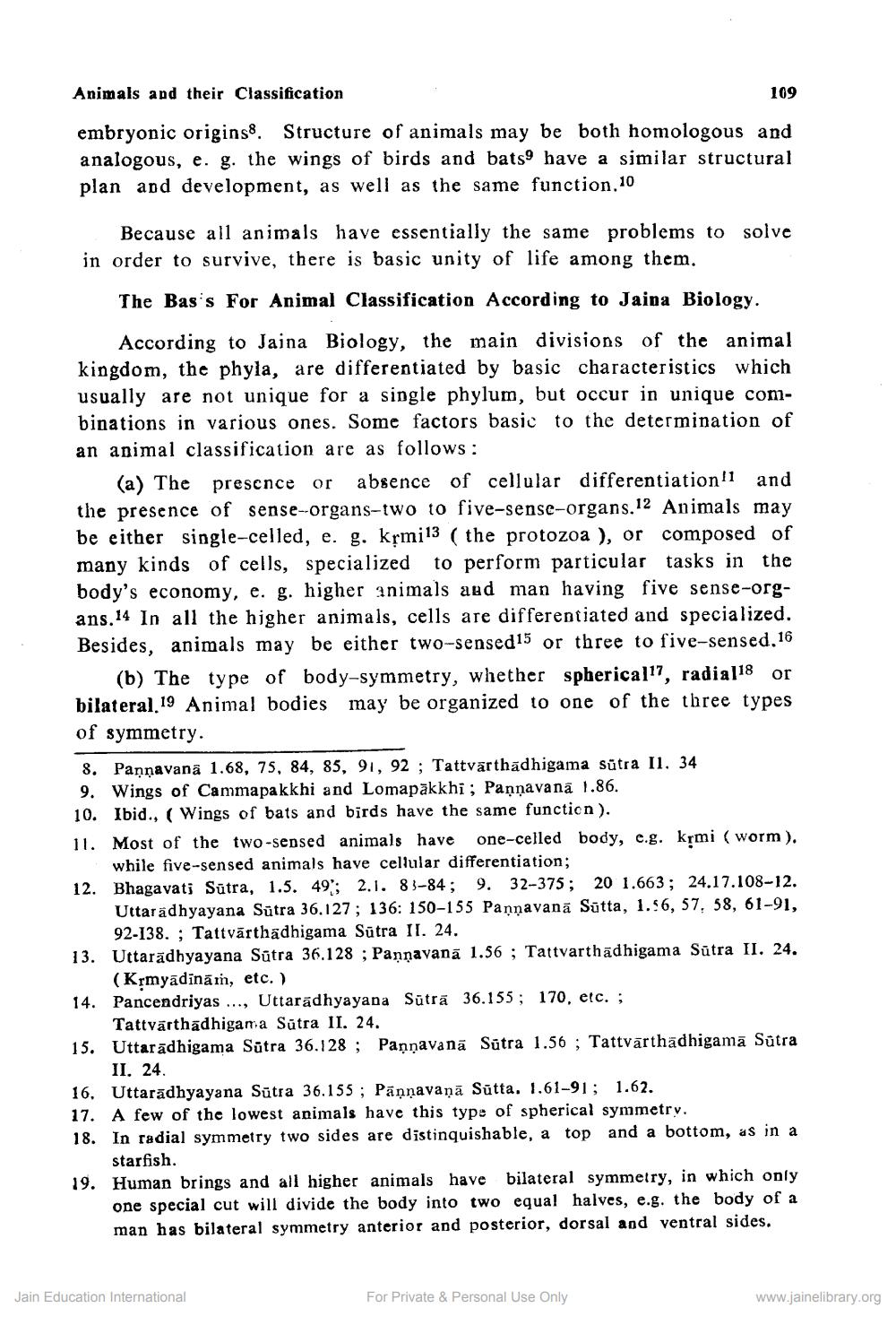________________
Animals and their classification
109
embryonic origins. Structure of animals may be both homologous and analogous, e. g. the wings of birds and batso have a similar structural plan apd development, as well as the same function 10
Because all animals have essentially the same problems to solve in order to survive, there is basic unity of life among them.
The Bas's For Animal Classification According to Jaina Biology.
According to Jaina Biology, the main divisions of the animal kingdom, the phyla, are differentiated by basic characteristics which usually are not unique for a single phylum, but occur in unique combinations in various ones. Some factors basic to the determination of an animal classification are as follows:
(a) The presence or absence of cellular differentiation and the presence of sense-organs-two to five-sense-organs.12 Animals may be either single-celled, e. g. krmi13 ( the protozoa ), or composed of many kinds of cells, specialized to perform particular tasks in the body's economy, e. g. higher animals and man having five sense-organs.14 In all the higher animals, cells are differentiated and specialized. Besides, animals may be either two-sensed 15 or three to five-sensed. 16
(b) The type of body-symmetry, whether spherical17, radial18 or bilateral. 19 Animal bodies may be organized to one of the three types of symmetry. 8. Pannavana 1.68, 75, 84, 85, 91, 92 ; Tattvarthadhigama sutra II. 34 9. Wings of Cammapakkhi and Lomapākkhi; Paņņavana 1.86. 10. Ibid., ( Wings of bats and birds have the same function). 11. Most of the two-sensed animals have one-celled body, e.g. krmi (worm).
while five--sensed animals have cellular differentiation; 12. Bhagavati Sūtra, 1.5. 49'; 2.1. 83-84; 9. 32-375; 20 1.663; 24.17.108-12.
Uttaradhyayana Sūtra 36.127; 136: 150-155 Pannavanā Sūtta, 1.6, 57, 58, 61-91,
92-138. ; Tattvārthadhigama Sūtra II. 24. 13. Uttaradhyayana Sūtra 36.128 ; Pannavana 1.56 ; Tattvarthadhigama Sutra II. 24.
(Kệmyādinām, etc.) 14. Pancendriyas ..., Uttaradhyayana Sūtrā 36.155; 170, etc.;
Tattvārthadhigama Sūtra II. 24. 15. Uttaradhigama Sutra 36.128 ; Pannavanā Sūtra 1.56 ; Tattvārthadhigama Sutra
II. 24. 16, Uttaradhyayana Sūtra 36.155 ; Pānnavaņā Sūtta. 1.61-91; 1.62. 17. A few of the lowest animals have this type of spherical symmetry. 18. In radial symmetry two sides are distinquishable, a top and a bottom, as in a
starfish. 19. Human brings and all higher animals have bilateral symmetry, in which only
one special cut will divide the body into two equal halves, e.g. the body of a man has bilateral symmetry anterior and posterior, dorsal and ventral sides.
Jain Education International
For Private & Personal Use Only
www.jainelibrary.org




